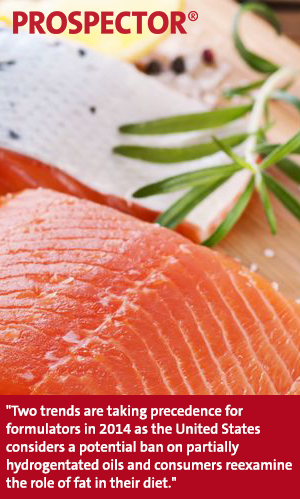A sleek curl of butter under the headline “Eat Butter”
graced the cover of TIME magazine at the end of June. The consumer-focused article reviewed newer research, which suggests fat as a category should not have been demonized in the fight against heart disease. Consumers are beginning to distinguish health benefits or consequences of specific types of fat.
While fat is necessary in the diet, dietary advice in the last few decades has focused on fat reduction to cut calories, lower heart disease and reverse obesity. Two trends are taking precedence for formulators in 2014 as the United States considers a potential ban on partially hydrogentated oils and consumers reexamine the role of fat in their diet.
Partially Hydrogenated Oil Removal
The use of partially hydrogenated oils (PHO) within the food industry has been dramatically reduced in the US over the last decade, as companies have reformulated with a focus of lowering or removing trans fat. Trans fat has been shown to not just increase bad cholesterol (LDL) but also lower good cholesterol (HDL), which leads to heart disease
In November 2013 the FDA issued a tentative determination that PHOs would no longer be considered GRAS and would be subject to regulation as food additives, which would require premarket approval. Comments were extended until March 2014, and industry stakeholders are asking the FDA to consider alternatives and/or a long phase in to prevent categories of food from disappearing from the shelves as products are reformulated to remove trace PHOs.
While more expensive and higher in saturated fat, using palm oil (EU), animal fats (EU), or butter (EU) may be quick substitutions for formulas with PHO.
Shifting Saturated Fat to Healthier Fats
With consumers looking for healthier fat profiles, processed foods can be reformulated to reduce and/or replace the saturated fat in a formula with healthier fats, like monounsaturated and polyunsaturated fats. Polyunsaturated fats like Omega 3 (EU), covered in a previous article, may enable health claims but require extra thought in product design to keep quality products over shelf life.
High oleic oils (EU), which are less prone to oxidation compared to other monounsaturates, are also lower in saturated fat. These oils typically have a neutral taste and high heat stability, making them a good choice for frying or spray-coating on the exterior of crackers or dried fruits. Many high oleic oils are non-GMO, but be aware that some high oleic oils can be sourced from genetically modified crops and may face consumer acceptability concerns. Other GMO oils with health benefits, like SDA enriched soybean oil – containing high levels of omega-3 stearadonic acid- will be reaching the ingredients market soon.
With trans on the out, oils high in saturated fat are often blended with other fats and oils to provide the functions of more plastic systems. Palm oil continues to meet functional demands, but palm oil faces sustainability challenges as well as high saturated fat levels. Palm oil blends (EU), mixing high saturated shortening with an unsaturated oil, like soybean oil (EU) or canola oil (EU) result in saturated fat reduction while maintaining the functional attributes of the shortening.
Fats and oils range in functionality under various processing conditions and desired final product attributes, so swapping one for another can be difficult without the expert advice of fat and oil vendors. Partnerships with your vendor will enable a smoother development plan; however, here are some ingredient suggestions to help get you on the right track.
Product Resources North America
Clear Valley® Omega-3 Shortening from Cargill Industrial Specialties
SansTrans™ RS-39 T20 from Loders Croklaan
Product Resources Europe
Clear Valley® High Oleic Canola Oil from Cargill Food Ingredients
SansTrans ™ 50 from Loders Croklaan
The views, opinions and technical analyses presented here are those of the author or advertiser, and are not necessarily those of ULProspector.com or UL Solutions. The appearance of this content in the UL Prospector Knowledge Center does not constitute an endorsement by UL Solutions or its affiliates.
All content is subject to copyright and may not be reproduced without prior authorization from UL Solutions or the content author.
The content has been made available for informational and educational purposes only. While the editors of this site may verify the accuracy of its content from time to time, we assume no responsibility for errors made by the author, editorial staff or any other contributor.
UL Solutions does not make any representations or warranties with respect to the accuracy, applicability, fitness or completeness of the content. UL Solutions does not warrant the performance, effectiveness or applicability of sites listed or linked to in any content.


